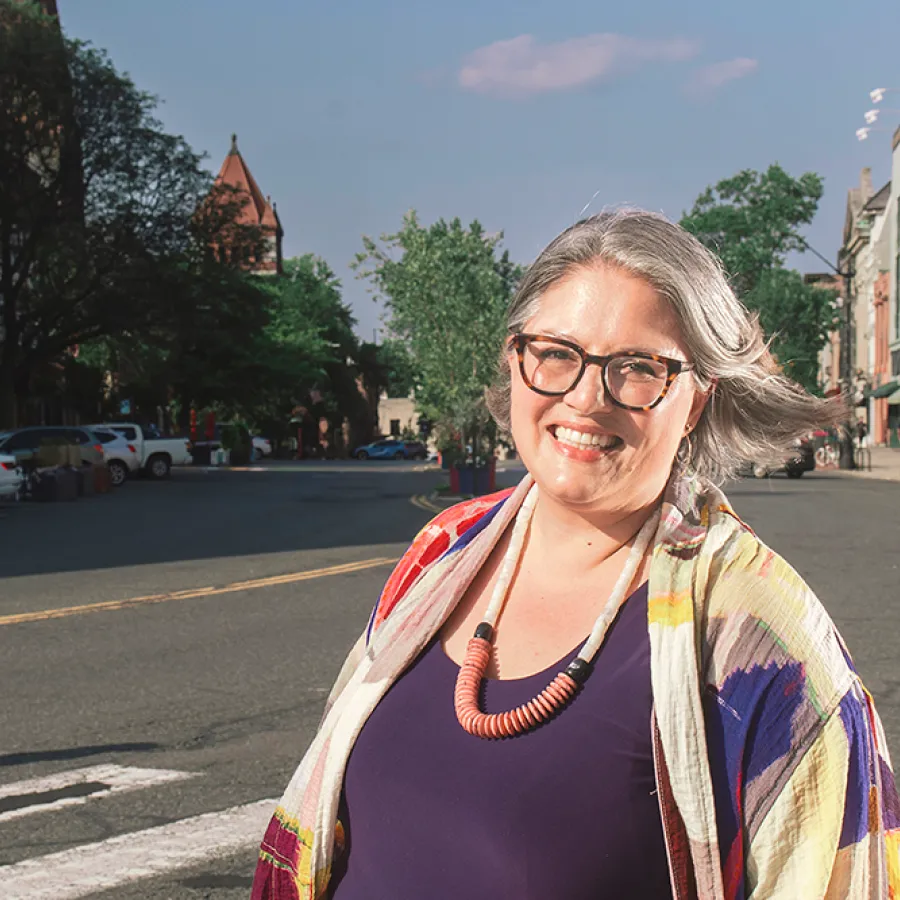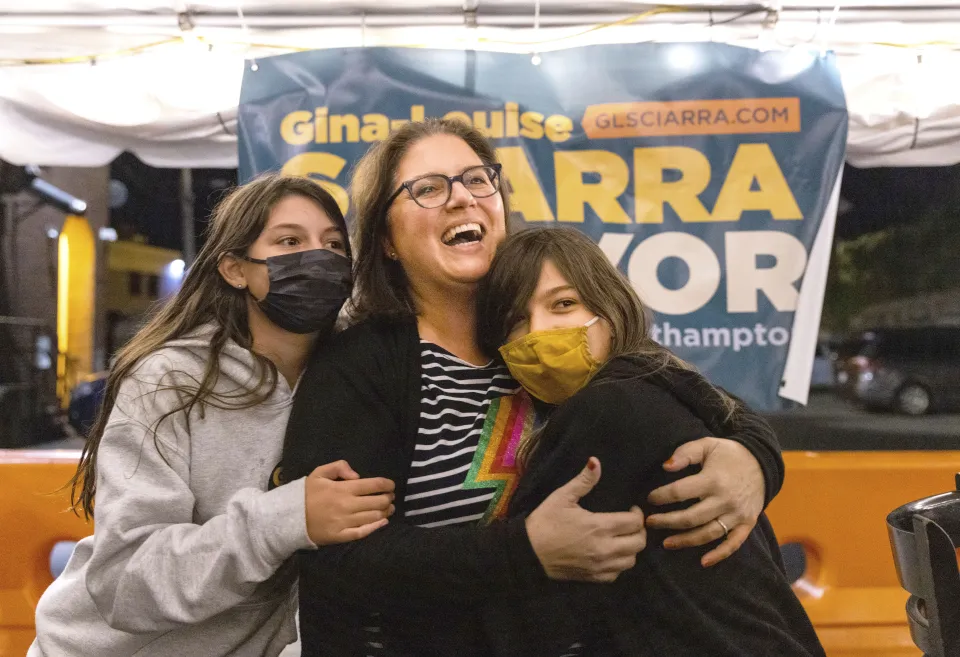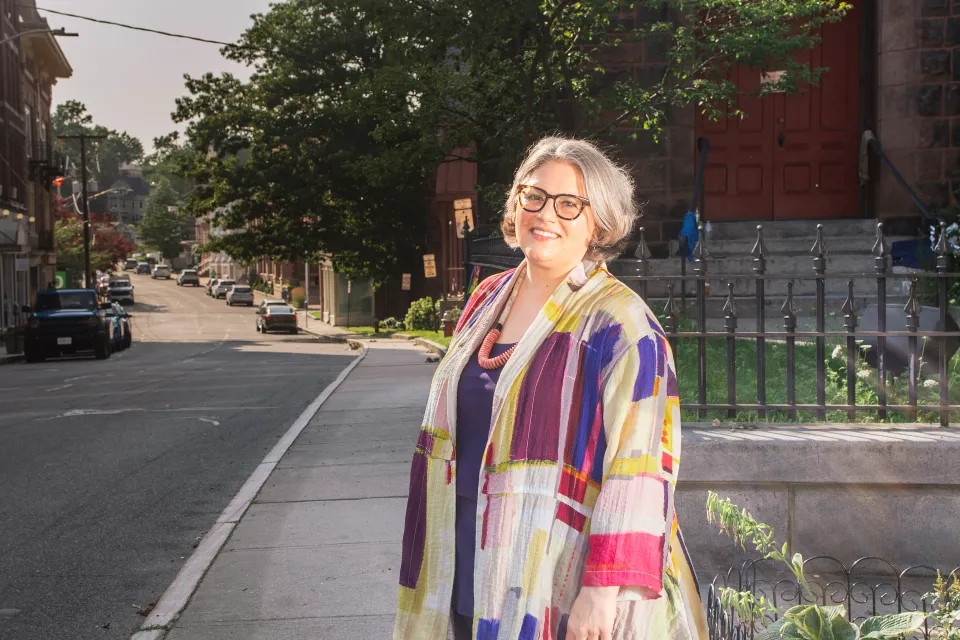Gina-Louise Sciarra ’96 Is Building a Better Northampton
Alum News
The city’s first Smithie mayor has a bold vision for the future—and it’s informed in part by her unique perspective on town-gown relations.
Published September 22, 2023
Through a window in her office at City Hall, Northampton Mayor Gina-Louise (G.L.) Sciarra ’96 can see the center of Main Street, and, with just a tilt of her head to the left, she has a perfect view of Smith’s College Hall. “It keeps me grounded to be able to see my alma mater and the center of Main Street,” Sciarra says. “There is a really beautiful symbiosis between Smith and Northampton, and to be a bridge between the two is something that’s really meaningful to me.”
An English major from Greenburgh, New York, Sciarra originally had her sights set on a career in publishing, but, after landing her first job after college at a political consulting firm in San Francisco, she realized that public service was a perfect fit—which came as no surprise to those who knew her. “I come from a family that was very interested in politics,” she says, “and we always had very spirited dinner conversations.” Sciarra remembers as a young child feeling “trapped” in the car while her mother listened to conservative talk radio. “I remember thinking, I know there’s a different point of view!”
After some years at the firm, where she worked her way up to art director, she and her husband, political writer and podcaster Bill Scher, moved to New York City. Sciarra took a position with the American Civil Liberties Union and earned a master of philosophy in sociology from the Graduate Center, City University of New York. She and Scher were both thinking about where they wanted to raise a family and kept coming back to how perfect a college town like Northampton would be. “This is silly,” Sciarra recalls saying. “Why don’t we just move to Northampton?” She says it was the best decision they ever made.
“There is a really beautiful symbiosis between Smith and Northampton.”
Sciarra and her husband now live in the center of town with their two daughters, ages 14 and 11. When the children were very young, Sciarra took on a nonprofit communications position and led a capital campaign for First Churches, the large stone Gothic church in the middle of Main Street. Becoming increasingly involved in the community, she headed a political campaign for a friend running for city councilor at large. When a city council seat opened up in her ward, Sciarra, a Democrat, went for it and won. She spent eight years on the city council and was unanimously elected city council president in 2020 before being sworn in as mayor in January 2022—the third woman and first Smith College graduate in the city’s history to hold the office.
Sciarra’s enthusiasm for changes planned for the city is palpable, but she is also grounded in a commitment to her constituents, including providing for the city’s most vulnerable residents. “I feel like all of my goals are really just based on doing the best I can for Northampton and our community,” she says.
What comes after the mayor’s office? “I really love working on campaigns, but I’m least comfortable trumpeting my own self,” Sciarra says. “I would be happy at some point to step back and just be able to support folks.”
And no matter what, she says, politics will always be central in her life. “I often joke that if you’re going to have my husband and myself over, we’re not going to bring much more to the table than politics—him on the national level and me on the local level.”
Here, Sciarra talks about her love for Northampton, how she sees the city evolving, her priorities as mayor, and the relationship between Northampton and Smith College.
Then-candidate Sciarra, center, celebrates her first-place finish in the preliminary election for Northampton mayor September 28, 2021, at Fitzwilly’s Restaurant with daughters Alazne, left, and Simone.
Photograph by the Republican
Why did you want to be the mayor of Northampton?
One of the reasons that I decided to run for mayor is that I spent the past eight years on the city council, and there were some things that I feel like the administration under former mayor David Narkewicz did really well. I thought it was important to have somebody who had been there through some of it and understood the financial components to carry it forward. I have also tried to bring issues that are important to me—like reproductive rights—to the city council and now the mayor’s office. Even in Northampton, there’s still so much work that we need to do to uphold a lot of our rights that, I think, in a more liberal place we take for granted—and we really can’t.
While many downtown businesses shut down because of the pandemic, empty storefronts started to appear several years before. Why?
I think the main thing that changed is how we interact with retail. People were already starting to buy things online. Do you remember the Mountain Goat? [A downtown staple for 24 years, it was a popular outdoor clothing and equipment retail business.] How we buy things changed rapidly. I remember hearing that staff would see people walk in and look at a North Face jacket, they’d look at the price tag, and then they’d pull out their phone and see how much it was online. Then the pandemic solidified patterns of online purchasing. Downtown Northampton needs to evolve to be more of an experience. What people are looking for in any downtown is experiential, so you need to meld that with retail.
How have you gone about reimagining downtown?
We have been focusing on economic development and providing programming that brings people downtown, especially in the warmer weather. The Center for the Arts and Historic Northampton are doing great things and becoming much more active spaces. This has all had a very positive effect. We can tell from our hotel, motel, and meals tax. These have fully recovered from the pandemic and have actually grown. So, more people are coming downtown, which then makes more people interested in starting businesses here. In the early summer alone, eight new businesses opened.
Data indicates that homeless people are attracted to college towns because these communities are usually more tolerant. Do you think there’s any validity to that?
I can only speak for myself, but I would say that we are a very progressive city. There’s a housing crisis nationwide, including here in the commonwealth [of Massachusetts] and in Northampton. There’s no question more folks are houseless. We’ve been working to help that part of our population. I think the federal and the state governments have failed to meet people’s needs, and that failure is really felt at the local level. I converted our health department to a health and human services department, in recognition that we are already picking up a lot of the slack from the other levels of government that aren’t getting the job done. We have also created the Division of Community Care, which will be a trained, unarmed response team to noncriminal calls. As a society, we’ve ended up relying on the police to respond to some of these deep-seated social issues. So, this is creating response teams who can go out and not only meet someone in crisis with a more appropriate response but also work with the Resilience Hub to connect them to services.
Describe the proposed plan to redesign the center of Northampton.
It is really an exciting plan for downtown, and it addresses how cities need to evolve. I’ve found pictures of Main Street from well over 100 years ago, and nothing has really changed. Even parking that had been for buggies is the same. Working with the Massachusetts Department of Transportation, we plan to create more space for people and a more environmental infrastructure by increasing the tree canopy, giving more room to sidewalks, and creating permanent summer outdoor dining space. I’m really prioritizing space for humans and recognizing not only how we use cars but also how cars themselves are changing. And I think that we need to take space back for people.
Mayor Sciarra’s Smith Memories
Academics: English major, Italian minor, JYA in Florence
House: Cushing
Most valuable Smith lesson: To support and stand up for women
Most embarrassing moment: At an event at Neilson Library, UMass students dressed as mythical troll creatures, and someone dressed as a troll “dog” bit me on the ankle
Most exhilarating moment: Being elected Cushing House president as a sophomore
Best place to party: The quad
Favorite Smith tradition: Every year, I still look forward to being awakened by the bells announcing Mountain Day, which can be heard from my house
Favorite place on campus: Neilson Library and Lyman Plant House
Because of Smith, I am: Fearless when standing up for other people’s rights
Talk about the relationship between Smith and Northampton.
I’m extremely proud of the relationship between Smith and Northampton. I think it has a particularly strong town and gown relationship. There’s shared admiration and appreciation between the college and the city. And I think that has created a uniquely positive relationship that is not the situation in every college town. I truly believe in the symbiosis of Northampton and Smith. When I first drove into Northampton, the feeling was so powerful that it was a critical deciding factor for me in choosing Smith. And Northampton wouldn’t be what it is if there wasn’t Smith. So, it’s really a marriage. I’m grateful to Smith because it’s my alma mater, and I appreciate what good stewards they are of a huge chunk of Northampton.
What are some of the major contributions that Smith has recently made to the city?
I view these in different layers. Smith going geothermal is a really important contribution to the city and our sustainability goals. And, monetarily, right before I became mayor, [former] President McCartney announced an unrestricted gift to the city of $500,000 over three years. Smith has given gifts periodically, but it was a pleasant surprise for me to be coming in as mayor and knowing I would have the benefit of a three-year, $500,000 unrestricted gift. Smith has donated used computers to the Northampton public schools, and local high school students are able to take Smith classes. There are many ways that I think Smith contributes to the city.
How does Northampton support Smith?
We provide city services to Smith gladly—fire, police, emergency services, infrastructure. And I think we create a welcoming and exciting environment for Smith students. Downtown and some of our recreational resources are things that I hope Smithies take advantage of.
How did Smith prepare you for your current position?
Smith encouraged me to speak my mind and to think critically. Without a doubt, I use these critical thinking skills every day. Smith also taught me to be open and to listen to different points of view and be able to have an open mind and take in information in many ways—but then also to have a center of core values and be able to defend them.
What is the most gratifying part of your job?
Serving my community and the unbelievable privilege I have to be at important moments of people’s lives. For example, I was on stage for Smith’s 2023 Commencement as every Smithie received their degree. I got to be on stage with [honorary degree recipient] Gabby Giffords! I get to shake the hand of every Northampton High School and Smith Vocational and Agricultural High School graduate. These are all amazing privileges.
What’s the most challenging part?
Cities are like any organization, right? It’s people working through challenges, dealing with interpersonal issues, and everybody’s got an opinion. People assume that unless we do what they think, that they weren’t heard, and that is not true. I try to always impart to constituents that I hear them. Even if I make a different decision than what they would like, it doesn’t mean I didn’t hear them
What should Smithies know about Northampton?
We are working really hard on Northampton’s vibrancy. I feel like Northampton is at this really exciting moment. We have some big changes coming up, and we’re working to push us into a new era for the future of the city. And any Smithies who do come to Northampton should always stop by City Hall and say hi—I’d love that!
Cheryl Dellecese is a senior editor at Smith.
Photograph by Leah Fasten
Small City, Big Impact
Two of Sciarra’s priorities for her administration tackle complex global problems on a small-city scale. But Sciarra is steadfast in her commitment to meet these challenges head-on. “One of the things that I love about Northampton is that we are a small city, but we are incredibly passionate,” she says. “We have strong opinions, and we are not scared to stand up for what’s right and to try to make the world better—even if it’s just our small corner.”
Sustainability
In 2018, the Northampton City Council endorsed a proposal by then-mayor David Narkewicz that Northampton become a net carbon-neutral city by 2050. Mayor Sciarra, who was president of the city council at the time, remains committed to that goal. The city’s comprehensive sustainability plan states that all municipal operations will be carbon neutral by 2030 and that community carbon emissions will be 50% lower by 2030 and 75% lower by 2040. The city plans to make good on its commitment to reduce its carbon footprint by changing how it does everything from purchasing power to managing watershed lands. To keep the city on track, Sciarra created a new department called Climate Action and Project Administration. Its staff will screen projects and purchases to ensure they align with sustainability goals and work with Sciarra to strategize and engage with the community. “Many thanks to Smith for helping us meet our citywide goals through its tremendous geothermal project,” she says.
Community Resilience
Northampton’s Community Resilience Hub was conceived as a place to support the needs of those experiencing homelessness and extreme poverty, to assist all community members during times of disaster and acute stress, and to improve emergency management. For those in need, it will serve as a day center offering community, food, showers, and a laundry. It will also be a center of information for local resources and programs, including housing organizations. “It will be a place where people can just be,” Sciarra says, “and access all these different services.” The hub will also be the home of the city’s recently formed Division of Community Care. Located next to Forbes Library on the site of the former First Baptist Church of Northampton, which has been vacant since 1993, the hub is slated to have some operations up and running by the end of 2024. —CHERYL DELLECESE


